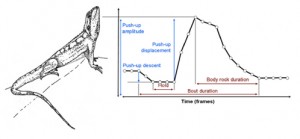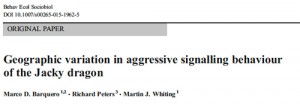Marco Barquero’s hard work has paid off! For his PhD, Marco travelled far and wide in his quest to study signalling in Jacky Dragons. Chapter 1 has just been published in Behavioral Ecology and Sociobiology. Marco studied three populations for which we had genetic data (thanks to Mitzy Pepper and Scott Keogh at the ANU) and also, morphology. He staged male:male trials to examine the extent of signal divergence and whether they discriminate among populations. It turns out that they have labile display behaviour but surprisingly, they do not appear to care what population a rival comes from and all are deemed equally threatening! This is contrary to findings from some other studies where more closely related populations are treated more aggressively.
This work was also in collaboration with our good friend Richard Peters at La Trobe University, who was Marco’s PhD cosupervisor (=coadvisor if you are from N. America!).

Figure 2 from Barquero et al. (2015). Sequence of the
movements involved in the pushup display of the Jacky dragon (drawing by Jose Ramos).
Here’s the abstract
Signal diversification is often the product of sexual and/or natural selection and may be accompanied by genetic differentiation or simply reflect a plastic response to social and environmental variables.We use an agamid lizard endemic to Australia, the Jacky dragon (Amphibolurus muricatus), to examine the relationships between population relatedness, morphology and signalling behaviour. We also tested whether males are able to discriminate among rivals from different populations and whether they respond more aggressively to more closely related populations. We studied three populations, two of which belong to the same genetic clade. Individuals from the two most closely related populations were also more similar in morphology than lizards from the third, more distant, population. However, all three populations differed in characteristics of their signalling behaviour including latency to display and the interval between displays. In addition, animals from all populations showed similar levels of aggression when matched with individuals from the same or different populations in staged trials and thus did not show evidence of population-level discrimination. We argue that display variation might be a consequence of behavioural plasticity and that, despite difference in genetic structure, morphology and behaviour, this species retains a cohesive communication system.
Barquero, M.D., Peters, R. & Whiting, M.J. 2015. Geographic variation in aggressive signalling behaviour of the Jacky dragon. Behavioral Ecology and Sociobiology DOI 10.1007/s00265-015-1962-5
Get the PDF

